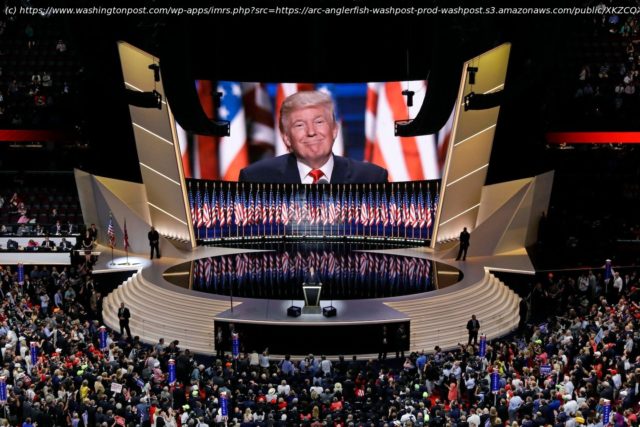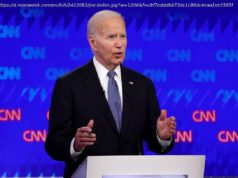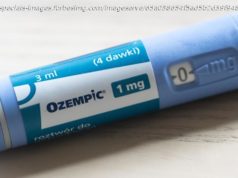A dark speech that foreshadowed much of what was to follow.
Over the course of Donald Trump’s five-year journey from unlikely candidate to president, only one night has given him exactly what he was looking for when it began. On July 21,2016, he walked onto the stage at the Republican National Convention in Cleveland before a raucous crowd of supporters. He’d vanquished more than a dozen opponents, however messily, upending the party establishment and sending experienced politicians into retirement. That night was a celebration of his victory — one deliberately tailored to his ego. It was constrained as he wanted it to be constrained and excessive the way he wanted it to be excessive. A forest of American flags were perfectly aligned at the back of the stage under a massive screen that at one point said nothing more than exactly what Trump would have wanted it to: Trump. In that moment, it seemed unlikely that Trump’s campaign would end successfully. He trailed Hillary Clinton relatively narrowly, but history suggested that his insurgent campaign would founder as the election approached. Despite his assertively unapologetic primary campaign, it seemed fair to expect that the speech he gave on that evening would attempt to establish a general-election campaign aimed at broadening his base. It didn’t. The speech Trump gave four years ago was, like so many other parts of Trump’s campaign, dark, angry, deceptive and aimed at riling up the people who already supported his candidacy. He offered a slew of projections and promises that, four years later, seem as bizarre and unlikely as they did then. Importantly, he detailed an approach to the job that seemed dissonant at the time but has been an undercurrent ever since. And, of course, he promised that he alone could fix the problems the nation faced. In November, voters will be asked to evaluate how he did. The speech began as one might expect. Trump formally accepted the nomination and then celebrated having received more primary votes than any previous Republican nominee. It was an accomplishment boosted both by high turnout, the relatively small number of prior candidates in the modern era and the expansion of the population of the United States. But it was a metric that could be parlayed into a victory lap, and so it was. Those niceties complete, Trump offered a concise summary of his thesis. “Together, we will lead our party back to the White House, and we will lead our country back to safety, prosperity and peace,” he said. “We will be a country of generosity and warmth. But we will also be a country of law and order.” There had been two events in the preceding several weeks that amplified that latter message. In mid-June, a man claiming loyalty to the Islamic State entered a gay nightclub in Orlando and killed more than 50 people. A few weeks later, a man in Dallas shot and killed five police officers as a Black Lives Matter protest was happening nearby. To Trump, these weren’t isolated acts of violence. They were evidence of a deep-seated danger. “Our convention occurs at a moment of crisis for our nation,” Trump continued. “The attacks on our police, and the terrorism in our cities, threaten our very way of life. Any politician who does not grasp this danger is not fit to lead our country.” He offered the country a promise. “I have a message for all of you: The crime and violence that today afflicts our nation will soon — and I mean very soon — come to an end,” he said. “Beginning on January 20th,2017, safety will be restored.” To many observers in the moment, it was a bit perplexing. Beyond the aforementioned incidents, it didn’t seem as though there was any particularly chaotic situation in the country. But it served Trump’s purposes to suggest that there was and that it demanded an immediate solution, so a speech that might have been expected to be an effort to embrace Democrats was instead largely a warning about what Democrats had wrought. The pattern Trump used in elevating the issue of crime was the pattern he used over and over throughout the rest of his speech. Present and exaggerate a problem, often using cherry-picked statistics. Insist that he — and only he — could and would quickly bring it to an end. His infamous “I alone can fix it” comment that came later in the speech referred somewhat narrowly to what he presented as a thorough corruption in Washington. While the line has been regularly offered out of that context, as we did above, the sentiment it encapsulates was pervasive. It’s hard not to consider Trump’s focus on crime and danger outside the context of the current moment. Trump’s reelection campaign has produced ads warning that his presumptive 2020 opponent, former vice president Joe Biden, would preside over similarly dangerous times should he win in November. To make that point, Trump’s campaign repeatedly highlights recent acts of violence — violence that, of course, has occurred under Trump. Four years ago, he isolated a few data points to suggest a country growing more dangerous. He noted increases in homicides in large cities, including Chicago and Washington, something he attributed to the Obama administration’s “rollback of criminal enforcement.” That violent crime had reached 40-year lows under President Barack Obama went unmentioned. In his first two years in office, the only two for which data are complete, the violent crime rate didn’t drop below the low point seen under Obama.
Start
United States
USA — Science Revisiting Trump’s acceptance speech from the Republican convention, four years later






